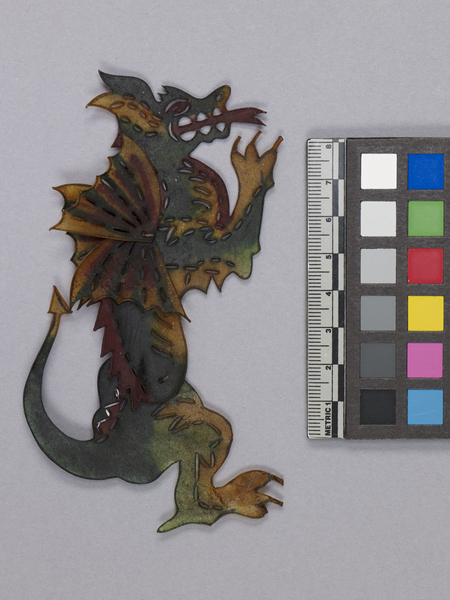Shadow Puppet Item Number: 3084/6 from the MOA: University of British Columbia

Description
Puppet depicting a dragon. Creature is separated into four parts attached to each other by plastic ties. Three small wings are attached to either side of the shoulder, and the lower legs and tail are attached to the torso near the hip. The dragon’s forked tongue emerges from a sharp toothed mouth and its front leg is raised, showing long claws. It stands upright on its large, clawed back feet, with its pointed tail raised. The skin of the object is punctured to show division between the limbs and for decoration.
History Of Use
Shadow puppet character, from the Turkish shadow play known as "Karagöz & Hacivat". The play dates back to the Ottoman Empire (c. 1299-1923). It follows the escapades and fights of the two central characters from whom it takes its name. These friends are opposites in many ways: Karagöz (Black Eye) is illiterate and coarse, but well-intentioned, and very funny. Whereas Hacivat is pretentious and conceited, well-spoken and amusing. The plays are full of wit and satire and social and ethnic stereotypes as well as supernatural characters, such as monsters and magicians. Karagöz shadow puppetry was inscribed on UNESCO’s List of the Intangible Cultural Heritage of Humanity in 2009.
Narrative
Collected by the donor in Istanbul in the early 1970s.
Item History
- Made in Turkey before 1970
- Collected in Istanbul, Turkey
- Owned by Rudi Kovanic before October 31, 2014
- Received from Rudi Kovanic (Donor) on October 31, 2014
What
Who
- Culture
- Turkish
- Previous Owner
- Rudi Kovanic
- Received from
- Rudi Kovanic (Donor)
Where
- Holding Institution
- MOA: University of British Columbia
- Made in
- Turkey
- Collected in
- Istanbul, Turkey
When
- Creation Date
- before 1970
- Ownership Date
- before October 31, 2014
- Acquisition Date
- on October 31, 2014
Other
- Condition
- good
- Accession Number
- 3084/0006